ISF/M-TLV Calibration Report Version 4.0
Something New, Something Old
The Art of Presenting Grayscale Calibration Work To The Public
(Jan 2004)
Greetings
This is going to be a quick update presenting version 4.0 of the ISF/M-TLV Calibration Template. It incorporates the formulas discussed in the January 2004 issue of Widescreen Review magazine and I direct all those that are interested to go read the articles for a better explanation of the theory.
In more simple terms, the revisions deal with how the human eye perceives differences in grayscale as we can see differences easier in certain colour ranges as compared to others. Errors in the green and red ranges are far easier to spot compared to errors in toward the blue. A smaller error to the green side can actually be more distracting than a larger error to the blue end of the spectrum.
This effect was touched upon in the text description of the previous version 3.0. Greg Rogers and Bill Cushman have taken this idea much further and have developed a mathematical relationship that weighs the X and Y values to account for the way the eye sees colours.
The end result is this “delta E” terminology and the numeric result is now included in the chart itself. High dE values are essentially undesirable while low ones mean a more accurate grayscale. In their article, they talk about how values of 3 or less mean essentially a perfect grayscale, and 5 or less being very good. 10 or less is tolerable … and so forth.
Regards
Michael @ The Laser Video Experience
Michael TLV writes:
Up until now, magazines and other information sources on Grayscale calibration presented results to a small, but curious public in the form of Grayscale graphs charting the colour temperature versus various intensities of gray. A sample of such a chart is shown below. We see these in all the home theatre magazines and some ISF calibrators provide their customers with something similar called the ISF calibration report where the primary focus is on the big before versus after graph.
Now by itself, the graph is a nice visual presentation of the TV’s grayscale tracking before calibration and after calibration. Now here comes the problem. The grayscale graph is a gross simplification of the grayscale calibration process and the science behind what is being done. (Although actually doing a grayscale is not that difficult with the proper tools.) It is presented in this graphical format because it is feared that the public cannot grasp anything slightly more complex about grayscale calibration and the basic theory behind it.
I bring this up because on not so rare occasions, the information presented on the graph is often extremely misleading. I have described the grayscale calibration graph to my clients as being something akin to a 2-D representation of something that is 3-D. I draw a sphere on a piece of paper and it looks like a circle. As a result, just because something looks close on a colourful graph may not actually mean anything. A blunt and extreme example that I like to use is to place your thumb into the night sky right next to the full moon.
From a two dimensional perspective, your thumb is now as large as the moon and possibly bigger. As such, can we walk away and conclude that the moon is not very large at all? In a two dimensional universe, the answer would be “yes.” Of course we inhabit a three dimensional universe so the answer is “no,” because we know that there is also a “Z” axis in three dimensional space. X,Y,Z coordinates in real space. Width, Height and Depth …
The grayscale charts that we see in magazines simply do not do justice to the grayscale calibration theory. And often times, a client will misinterpret these same grayscale graphs and conclude that his TV was so closely tracking grayscale out of the box than he did not really need to hire you in the first place. Yes, there are cases where some TVs really are close from the factory, but this has been fairly rare and so far, continues to be rare. It’s just that sinking feeling that one gets when his client misunderstands the grayscale chart information. When this happens, you can end up with an unhappy client and everything goes sour on you (doubtful, but possible).
I want to bring in a few exhibits here that are gross exaggerations, but do, hopefully, get the point across. The grayscale calibration chart sample below represents the major deficiency of the current graphical presentation method. We have a case where the pre-calibration grayscale tracking appears to closely resemble the post calibration grayscale tracking.
The reaction from the uneducated public would be that the TV in question was pretty accurate out of the box and that the calibrator probably did not have to do very much if anything at all to fix this. This is what a graph shows you … and this is what the image actually looked like before calibration versus after calibration.
It is nearly impossible for the home theatre publications to present to us what the actual image looks like on the TV. Hence we have the grayscale calibration charts that are easy to translate to print. Now the pre-calibration image of the resident Furry Pig is quite simply … all wrong. It is too green. The post calibrated image is pretty much where the image should be and yet the graph doesn’t show this at all. This is why the calibrated grayscale graph that we see in magazines have the potential to also be terribly misleading. Good data presented the wrong way can lead to unfortunate and erroneous conclusions.
Of course the fact that I am presenting images on a web site also introduces a plethora of potential errors. The irony of this fact did dawn on me. All images are therefore presented for illustration purposes only. I have to figure that even the poorest tuned computer monitors out there will at least be able to show the reader that the two images of the Furry Pig look distinctly different. How that difference is manifested on the screen, I have no idea.
From the two-dimensional perspective, it is the same as your thumb being as big as the moon. Now imagine that you can see 12 inches behind the graph and 12 inches in front of it. The further behind the graph you go, the greener your image becomes. The further in front you get, the more red/purple the image becomes. The green pre-calibration Furry Pig is actually located six inches behind the graph. The post calibration Furry Pig is located on the graph itself. The idea in calibration is to get the curve onto the surface of the graph itself too, not in front or in back. This is what D6500K is all about. There are lots of 6500K readings both in front of the chart as well as behind it. Sometimes, the curious public loses sight of this and simply gets focused on the magic 6500K number thinking that it is only the number 6500 that is all important.
So the big question is, how do we present the public with something that is more informative and gives a better representation of the actual grayscale calibration process and yet does not make them roll their eyes in confusion. There must be some way to properly quantify how much better the grayscale tracking is after the calibration process. Presenting the client with a graph like in Sample #2 is undesirable and has the potential to send the wrong message. It ultimately tells the client little to nothing in terms of pre-calibration and post calibration. (Although in the end, we all let our eyes be the judge of how good or bad things really are and someone passing off that green Furry Pig as being a properly calibrated image would never get away with it regardless of how the numbers read. This is a good thing. =)
The quest is to find a better way of expressing the way the TV was before and after a calibration session when it comes to grayscale tracking while keeping it simple enough for people (re: enthusiast) to understand. Enter the following spreadsheet chart.
| The ISF/M-TLV Calibration Report Version 4.0 |
Although this is nowhere near as colourful as the typical grayscale tracking chart found in magazines, it is easy to use and far more accurate in terms of telling the client just how different his pre-calibration grayscale was compared to the post calibration grayscale. (Actually, most magazines present the graphs in black and white so there are no colours to speak of anyway.) It provides a much better view of just how good or bad a client’s grayscale tracking was. The sheet still provides information at each light intensity tested, (IRE window box patterns) just like the graphs, but instead of the colour temperature reading, we get X and Y coordinates in what is known as colour space. This is how we actually do it as opposed to looking for that 6500K colour temperature.
|
|
..
|
|
A quick and simple explanation of the CIE chromaticity chart is that it represents all the colours that the human eye can pretty much see. Our eyes can see many more colours than what a TV is capable of producing though or even what a magazine is capable of printing. There is a specific point on this chart that represents what neutral colour information is, a point where black and white information is considered to be absolutely neutral. (not tinted blue or green or red.) This point on the graph is denoted by the coordinates X=0.313, Y=0.329. You do not have to burn these numbers into your head. Just know that they represent the D6500K point that we strive to achieve.
The only thing the end user needs to be aware of on the chart is the last column of numbers. The percentages are nice and easy to understand. The big “93.9%” figure tells the client how much more accurate his grayscale tracking is compared to when you started. It much better quantifies the work that you do for the client. The more whacked out the TV is compared to the post calibration state, the better the overall percentage number. The lower the percentage number, the closer the TV was to being accurate. So if the overall improvement is 10% … you know the set was pretty accurate to begin with (or the calibrator is terribly incompetent or there is a major problem with the TV. ) The calibrator is still expected to get the grayscale as good as possible.
I encountered a 1997 Sony 61” XBR RPTV recently and the set tracked grayscale fairly poorly and it was near impossible to even get something close to correct. The end result showed an improvement of 34% compared to the pre-calibration result so low numbers do not have to imply that the TV was more accurate.
The final percentage numbers cannot be used to compare grayscale tracking between two different TV’s though. The numbers are only relevant for the display that the values were taken from. A 95% improvement on one display is not necessarily better than a 50% improvement on a second unit. The sheet does, however, present a set of numbers than can be compared to other TV’s. The directly comparable numbers are the “Distance to D6500” values. If my pre-calibration totals are less then yours, then my set was closer to optimal at the start. If my post calibration totals are more than yours, then my set tracks worse than yours … regardless of the percent improvement figure. Although not normally used by the client, the information is still presented. This actually permits two separate people to compare notes … if the same calibrator worked on both their TVs.
The Bias-Tint column can be used by the client to judge the imperfections of the grayscale in the display. At any of the tested IRE windows, this box tells them exactly what type of slight tint they may be seeing. At the low IRE windows, it is better to have the tint be blue than green, but if the improvement is really close, then do not worry about it. Let your eyes be the final judge.
This article is not about teaching people to properly calibrate the grayscale on the TV. It is about presenting the information to the client in a more meaningful manner and yet not totally confusing the client. While presenting much more information than the client needs, the tale of the tape is in the final column.
The breakdown of the sheet is also provided with all the graphics design work credited to Errol. The spreadsheet also includes a number of comments about the various columns in terms of what I am trying to achieve.
I have made a copy of the spreadsheet available for download at this site for those people / calibrators curious to try this manner of presentation out.
I will be testing out this output format for my clients over the next few months. This form also has potential to be used in conjunction with the standard ISF report format. It merely replaces the graph on the report. Unfortunately, the formulas that are part of the spread sheet require that values be entered into a spreadsheet first.


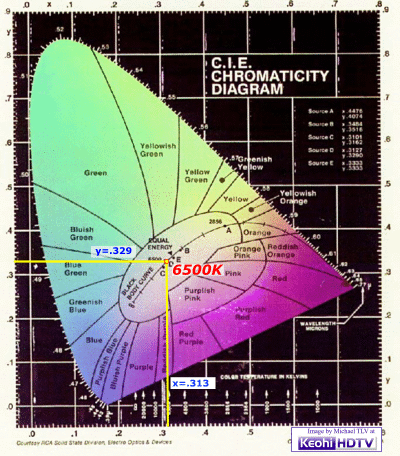
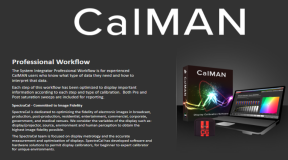
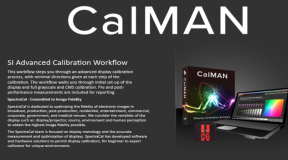

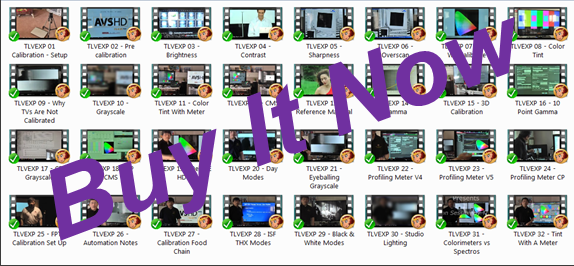
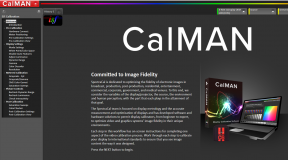
4 Comments
spacediver
(September 20, 2013 - 11:22 am)I’m having trouble understanding how the charts present more information than the color temperature tracking graph. What is this third dimension you allude to that is missing in the graph but not the chart?
tlvexp
(September 20, 2013 - 12:06 pm)Bear in mind you are looking at an article written 9 years ago when no one had digital displays and it was still mostly a CRT world. People knew so much less about the world of calibration back then. We used stone knives and bear skins at a time too. The graph showing color temp is trying to depict something that has two dimensions in the case of the CIE chart. The Graph is a one dimensional representation.
Color Temperature be it 6500K or something else is represented by a line on a graph on the CIE chart. This line travels from green down to magenta. Anywhere along the line, the color temp is still the same 6500K. So if I tell you my color temp is 6500K … what am I actually telling you? Very little. You don’t know if the image is too green or too purple or just right. d65 is one point on this 6500K line. The line itself has an infinite number of points. In calibration, only one of these is correct.
spacediver
(September 20, 2013 - 12:34 pm)ah, that makes sense! I conflated d65 with 6500K without knowing there was a difference. And point taken about the historical context of the article.
spacediver
(September 20, 2013 - 11:30 am)my previous post rested on the assumption that the 6500 color temperature value in the graph refers to a specific color coordinate. If this is not true, then I can understand your argument.